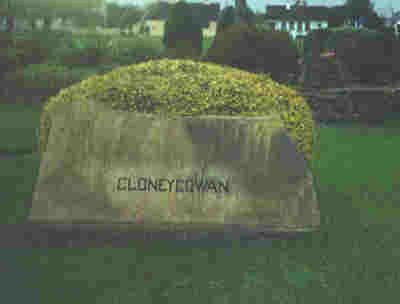THE HISTORY OF CLONEYGOWAN
At the beginning Cloneygowan
had a brewery,an R.U.C barracks, and two forges which were owned by Tim
McDonald and Dennis Hyland.
Where
Gormans foodmarket is now there used to be a brewery owned by a man
who started the Odlums company.
The old school was closed the
same year the new school was opened[1956]. There used to be an old R.U.C.
barracks across from where the new school was built. It was burnt
around 1916-1918 [weapons such as muskets and pikes were found in the area
and were stored for a time in the new school].
There used to be an old forge
beside the old school owned by Dennis Hyland and the other forge was at
the Portarlington end of the village. It was owned by Tim Mcdonald. The
first principal of the old school was Thomas Farrell and the first principal
of the new school was Michael Moran.
There used to be an old
thatched pub where Dolanís pub now stands.
A Little History
of Offaly
Facts in brief about Offaly
Population: 1991 census-58,448
Area: 1,998
Largest towns: Tullamore,
Birr, Edenderry, Clara, Banagher, Ferbane
Chief products: Agriculture-
barley, cattle, milk. Other primary products-peat, sand, gravel, timber.
Manufacturing- building materials, clothing, engineering goods, footwear,
meat products, plastic goods, textiles, timber products.
Origin of name: From the Irish
Uíbh Fhailí (descendants of Failghe who was an Irish prince).
People and government:
About 95 per cent of the people of Offaly are Roman Catholics. Almost all
those of other Religions are members of the Church of Ireland.
Offaly and Laois form
one constituency, which elects five members to Dáil Éireann.
Local government is carried out through a county council in Tullamore.
Economy:One-fifth
of people in Offaly work in agriculture. Beef cattle production is the
leading type of farming. Farmers also raise dairy cattle, sheep, pigs,
poultry, and mixed farming is also common. Arable crops include barley,
potatoes, sugar beet, turnips and wheat.
One-fifth of employment
is in manufacturing. The main industrial centre is Tullamore. Its industries
include building materials, clothing, meat products, medical supplies and
textiles. The main groups of manufacturing in Offaly are clothing and textiles,
engineering supplies and food processing.
The various service
industries account for two-fifths of employment. The largest number of
people work in retail and wholesale distribution. Others work in catering,
education, health care and transport.
Peat production is more
important to the economy of Offaly than in any other Irish county. There
are peat-burning power stations at Ferbane, Rhode and Shannonbridge, and
a peat briquette factory near Tullamore. New forests cover some bog land
and areas of the Slieve Bloom Mountains.
The main railway
line from Dublin to the western counties of Galway and Mayo passes
through Offaly. The N6 and N7 roads pass along small sections of the southern
and northern borders. The N80 from the port of Rosslare to the west and
northwest and the N62 from Limerick to Athlone also cross the county.
Land: Counties Westmeath
and Meath are to the north of Offaly, Kildare to the east, Laois and Tipperary
to the south, and Galway and Roscommon to the west. Most of Offaly is flat
lowland. The land slopes gently towards the River Shannon, which forms
the western boundary of the county. Extensive peat bogs have developed
in poorly drained areas. The bog land of the east is part of the large
Bog of Allen. Along the Laois border in the south runs part of the Slieve
Bloom Mountains.
Rainfall averages
100 centimetres a year. The average temperature is 5 oC in January and
15 oC in July.
History:Archaeologists
have found evidence that there were people in Offaly about 9,000 years
ago. Much later it was the ancient kingdom of Uí Fáilge (now
Uíbh Failí. Offaly was renamed Kingís County in the 1500s
by Queen Mary.
|
